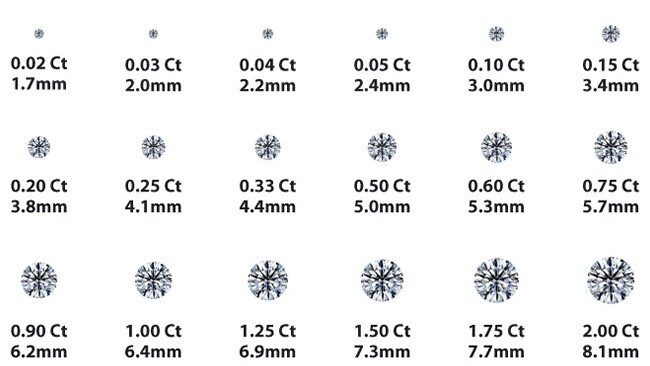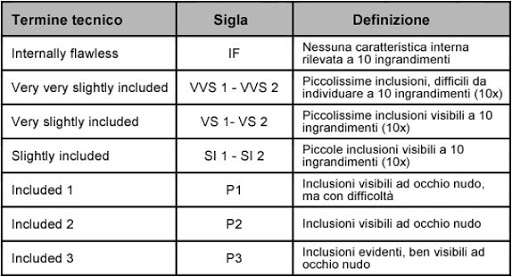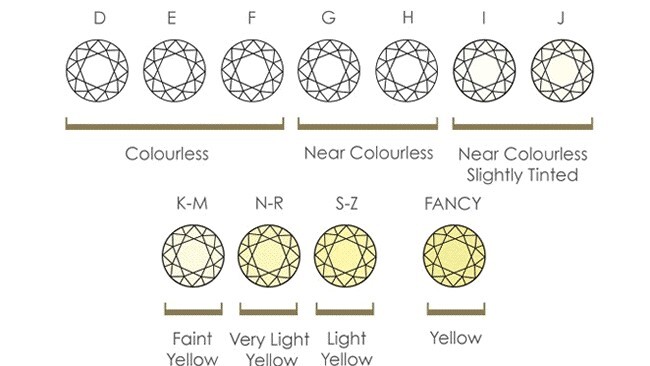The four "C"
The factors that determine the value of the diamond are the four "C", from the initials of the four terms in English that is: color, clarity, cut and carat (ie weight).
WEIGHT OF DIAMOND (CARAT)
The weight of precious stones is defined in the unit of measurement "carat", since in ancient times the weight of the carob seed (0.197 grams, extraordinarily - as extraordinary is always nature - with very few exceptions) was compared to that of crystals, in widespread use in the eighteenth century of the double scales.
In 1907 the weight of the etymologically transformed sound of "carob" was fixed at an international level, in "carat" and made to correspond to gr. 0.2. A stone weighing one gram, therefore, will be appropriately classified into five carats, the abbreviation written correctly will be: ct. 5.00. It is important to know that hundredths of a carat are widely used in the common gemological language: for the expert, a 52-point diamond will be a single stone of just over half a carat. Thus, each carat has 100 points.
Diamond weight and diameter
Below, a table illustrates the relationship between weight (in carats) and diameter of the stone (in millimeters).

DIAMOND PURITY (CLARITY)
The inclusions of the diamond
Clarity refers to the purity of the stone, or rather to the presence, more or less consistent, of various kinds of inclusions (impurities inside the crystal). The stone must be observed under a special lens (loupe), also known as a "triplet", at ten magnification, to establish which of the following orders of purity is the one that precisely defines the crystal we evaluate: The degree of presence and the dislocation of these inclusions can significantly modify the appearance of the gem and its value.
Different degrees of purity of a diamond
Below, a table lists the acronyms and their meaning linked to the purity of the gem.

Artificial modification of the inclusions of a diamond
Happen, at times, that some black inclusions are artificially modified. With the help of a laser beam, a channel is created which from the outside reaches the inclusion which is subsequently dissolved by means of an acid. After the treatment, there will remain a cavity in relation to the outside by means of a thin channel (and, wearing the jewel, the inclusion could turn black again due to the dust that penetrates inside). These small cavities can be plugged thanks to special materials, disguising the naked eye, artificially changing the degree of purity of these treated diamonds. This treatment is known to be employed in Israel (Koss company, Yehuda).
THE CUT AND BRILLIANCE OF A DIAMOND (CUT)
The "cut" refers to the type of cut but, more importantly for evaluation purposes, to the proportionality and accuracy, according to predefined percentage canons, of the measures and inclination (measured in degrees) of each individual facet, at in order to obtain, on the whole of the various parts, an almost total reflection of light, with the obtaining of that sum of lights and colors that we define, precisely, brilliance.
An example: the diamond, the stone that is most often cut to "brilliant" (compound cut in a round shape with 56 facets plus the table), must observe some well-defined proportions that regulate the relationships between the diameter (measured from the ), the upper table, the pavilion (the underlying body, in the shape of a faceted cone), the crown (double order of facets between the belt, the widest part of the stone in terms of circumference, and the upper table, smooth, flat part, front to the observer).
Any error detected in the cut, which can be mathematically measured with the aid of the gauge or by means of the “proportion scope” instrument, penalizes the reflection of light and the brilliance and, from the point of view of the estimate, the value of the stone.
Similar speeches can be made about many other beautiful cuts used to make the diamond shine:
heart, baguette, marquise, yoke, emerald, teardrop cut, etc. but remembering that a diamond cut "rose" or "brilliant old Europe" or "old mine" (Old Mine), will perhaps be worth less in terms of quotation, will perhaps be less brazen in returning to our eye the light dispersed in the seven colors , but the refined brilliance of a "cushion" cut, now forgotten for more than a century, could give us the emotion of the past, the memory of techniques that are no longer in use, the refined pleasure of wearing or investing in a historical piece and of cultural value.
THE COLOR OF DIAMONDS (COLOR)
Color is the word which defines, in the case of the diamond, the amount of yellow over-coloring that is added to the white of the stone, causing a decrease in value the more it is present. I remember that the word "white", in gemology, means "transparent" without any inflection from other colors. It is defined with the letters of the alphabet (.. English) starting from "D", the whitest color,
and quoting the stones up to the "M", but ending, in reality albeit not commercially speaking, with the "Z" and "Z +" or the colored and "fancy colors", extraordinary and very expensive jokes of nature that tinge with blue ultramarine, carmine red, canary yellow, purple, pink, orange, green, etc. our diamond, a real rarity whose value is established only by the previous auction.
The technique to precisely define the color of a diamond is to place it in Nordic light (a particular white light poor in ultraviolet rays), in a neutral field (white environment not influenced by colors of any kind) and with the help of "master stones ”, Touch stones graduated in the shade and corresponding to the aforementioned letters of the alphabet.
.
Letters and colors of diamonds
Below, a table listing the letters associated with the respective colors.





